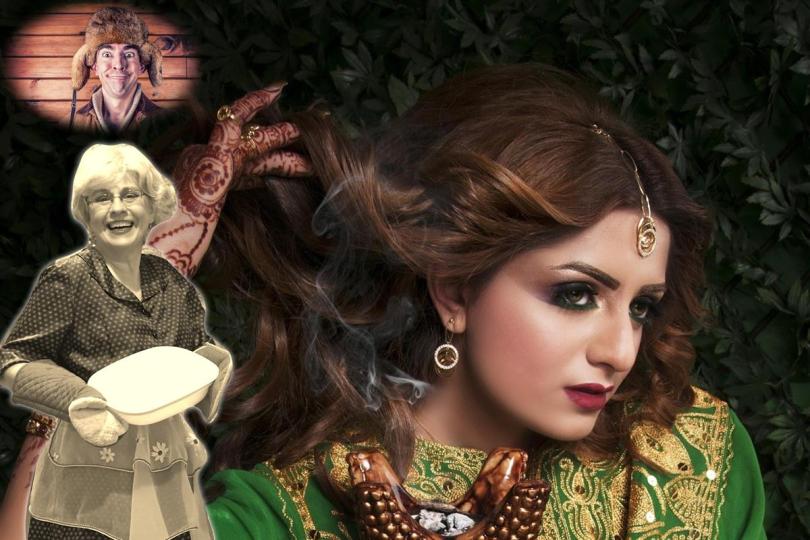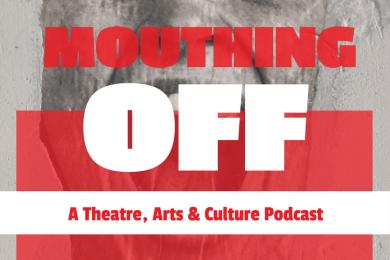“Saree-ously Speaking: Uff-Dah!”

Saree-ously Speaking: Uff-Dah! will be performing at the Rarig Thrust Stage from August 6-12 as part of the Minnesota Fringe Festival.
Show Description: A wealthy family of Indian descent relocates to a small town in Minnesota for an unsurpassable opportunity. Hilarity ensues as the tight-knit community intersects with the new residents. Emotions are high, especially when the men foresee uncertainty about jobs, women are bonding over chai and hot-dishes while the teenagers are discovering their identities and love. Will the Indian family be cooking Lutefisk and baking seven-layer bars or will the locals be gyrating to Bollywood rhythms?
How would you describe yourself and how did you first start doing theatre?
I am a creative artist and a social media enthusiast. I first got involved in theatre through school. I was particularly involved in dancing and short skits for our school’s annual day. Theatre though not a structured curriculum back home in India, is considered an essential for school and social events, especially dancing. After moving to Minnesota, I got involved in the production of the "Vaisakhi Mela" show for MN Punjabi Society. Master of ceremonies, dancer, actor, director and choreographer... I would wear whatever hat was required to keep the show going. From there, many local organizations started reaching out when they needed talent. Although I have been involved with MN Fringe, I am really excited for my producer debut with Saree-ously Speaking? Uffda!
You’re a member of the Sikh community and you’ve been involved in local Sikh cultural activities. Can you tell us a little bit about the Sikh religion and culture and how that informed your work on this show?
I am a member of Sikh community and enjoy participating in regional and folk dances called Gidda and Bhangra. I hope to feature a Bhangra segment in our show in addition to a Bollywood dance as a tribute to Bollywood actress Sridevi who passed away this year.
I was born into a Sikh family, went to catholic school from K-12 and married a Hindu. I truly believe there is one God and different religions are just different routes leading to the same destination called spiritual fulfillment.
Sikhism is one of the youngest religion in the world dating back to 18t h century. To be a Sikh means to be a “seeker of truth” and “believer of racial and gender equality”. The key Sikh values that my family emphasized growing up were (Naam Japo) (Keerat Karo) (Vand ke Shako) which means “Pray”, “Do Your Duties”, “Share your Good Fortune”. Therefore, practicing Sikhism became more of a way of living than a religion to me. These core values were my inspiration to create a show celebrating diversity and differences and the foundation for my desire to donate proceeds.
For those readers who aren’t familiar with the genre, can you give a brief description of Bollywood? Also where did the term Mollywood come from and what’s the difference between Mollywood versus Bollywood?
Indian Hindi cinema is often referred to as “Bollywood”. The term is a portmanteau of "Bombay" and "Hollywood". Since Bollywood originated in Bombay, its derivative in MN was named “Mollywood” by my creative self (wink!). Bollywood movies usually are light hearted entertainment primarily including glitz, glamor, love, romance, music and dancing.
I would say Mollywood’s new production Saree-ously Speaking? Uffda! is an amalgamation of the bollywood, comedy and drama.
What motivated you to write and produce Saree-ously Speaking?
To begin with I wanted to create a show “Sikhs-a mistaken identity”, a topic that is very dear to my heart. Sikhs due to their appearance are often subject to unfair biases. However, as the project evolved I considered exploring broader biases that everyone encounters, due to being different than the others. Diversity and Inclusion , woven into a light hearted, fun and witty comedy became the vision.
Can you describe the evolution of the production?
It all started when I won the fringe lottery. I had put my name in and tried to forget about it. “I never win” was my mindset. I couldn’t believe, when I saw numbers 551 on twitter. I had to cross check to make sure, its me. At this point, I had no one on my team and no story, just a vision and an idea. Well from that day on I reached out to multiple people and started forming a team. I am very grateful, honored and proud that many talented artists embarked on this journey with me. Fringe is a very collaborative process and every artist has brought in a bit of themselves into this show. That’s what has made it fun and exciting process. I personally have learnt a lot about Lutefisk and “Bunna” [Ethopian Coffee Ceremony].
Who is on the team of writers? How did you go about working together to create the script?
Brianna Sundgaard is the first writer we got on board. Nick Radovich became our small-town MN consultant. My main goal from the story/plot was to revolve around biases and differences that divide us as humans, although we all have the same basic needs and goals in life. Robert, Brianna, Nick and I had many rounds of brain storming sessions before we settled on a main plot “Indian Family moving to small town MN”. At this point Lakshmi Ramakrishanan came on board. Brianna and Lakshmi started bringing the vision to life. They created fun and witty characters that live in small town MN and the Indian family that moves in. Over the course of the month they had several writing sessions together creating the basic plot and foundation of the story. Lakshmi brought in Indian family’s perspective while Brianna took on the local’s response to the events happening in the play. It was nice to have Indian and American perspectives covered by two writers. Once the script was released further changes were made by Robert and I, keeping in mind the cast we brought on board and scene transitions. Additional changes were made to add comedy, highlight a few partners and sponsors. Our goal remained the same to deliver the key message in a light hearted fun way.
Sareeously touches on a range of social and political issues. Are there any that are particularly important to you?
What breaks my heart is that regardless of the contributions, energy and enrichment that different people bring to our communities and/or corporate teams, being different continues to be a reason of prejudice and negativity. (Uffda!)
The issue that is close to my heart and is especially true for many Indian families even those that are highly progressive and educated, is that we are a society of people with double-standards as far as our attitude towards women is concerned; our thoughts and preaching are different than our actions.
Women are performing exceptionally well professionally as well as at home. They serve as daughters, sisters, wives, mothers, grandmothers at home and have professionally made an impact in various fields like social, economical, political, educational, scientific and other nation- building activities. Even after huge improvement in the women status in India, they are still often undermined and are considered responsible to care for their husbands, in-laws and kids as their primary duty.
The character “Radhika” falls under the realm of this patriarchal and hierarchical system and is expected to show deference to her husband and mother in law. She continues to play a supportive role in furthering her husband’s agenda. While Radhika has been socio-culturally conditioned to accept her subordinate position to husband and his family, Sweetie, continues to defy the norms and live by her own rules.
“Rohit” defies the “model minority" myth, in- particular, the notion that Asians are culturally — even genetically — endowed with the characteristics that enable them to succeed academically.
My goal was also to highlight that snake charmers and dancing though popular in Indian society are not the part of every-day living and have entertainment value only.
While “Matthew” is not the town’s favorite for not living by the rules of small town and for having different interests than other boys, “Tina” is frowned upon for having an unconventional way of living.
This play also addresses scaremongering stories that jobs that will disappear due to immigrants and technology, but the reality is that the jobs that our children will perform decades from now, don’t even exist today. With robotics and technology increasingly becoming a part of our daily lives, the conventional wisdom among economists holds that, while there may be some short-term job loss at the hands of automation, the vacuum will ultimately fill in over time. This notion echoes the historical precedent of things like the agriculture and printing. There is probably something to the notion in some cases that increased productivity and margins provide companies with funds that allow them to expand their size and employment ranks.
I tried to highlight some of these facts by creating a light-hearted fun play.
Saree-ously has a very large cast as well as a group of dancers. How many people appear in the show altogether? And what has it been like for you and the leadership team managing such a large group?
Yes, we are a large group, my big fat Indo-American theatre family. It has been a lot of fun getting to know everyone. A few folks I am working with for the first time while others I have either acted or danced with from prior productions. There’s a total of 18 actors and 12 dancers on stage. Not including the stage manager, set designers, directors, videographer, photographer and admin help. Saree-ously! took a village to put this together.
What has worked best is to hold separate rehearsals for dancers and actors. This way everyone’s times is being used efficiently and no one is waiting upon the others. We also broke down the rehearsal process and call times for actors were based on the scene work that was scheduled. Talent that appear later in the show did not have to commit to rehearsal early on, in the process. As show time is getting closer, we have started to host combined rehearsals. While it is hard to bring together a large group, especially finding bigger rehearsal spaces, there are some perks as well. There is always someone to offer a helping hand when needed.
You’ve brought together very experienced actors with some folks like Amit for whom Sareeously will be their first acting experience. Can you talk about how you and Robert went about casting the show?
Our casting team included writers Brianna and Lakshmi, Director Robert and me as a producer. We held multiple auditions and were extremely happy with the interest. Mollywood Productions’ mission is to connect, promote and support Minnesota talent and performing arts. To support this vision, providing resources and opportunities to local talent was at the forefront. In a desire to build careers and an affluent social economic presence, we south Asians offer leave creative arts behind. I want to build a community of actors and performing artists within our South Asian Indian community. Therefore, casting actors like Manju and Amit who have not acted before was encouraged than it being a barrier. Saree-osuly! what a treat to have highly talented and veteran artists by your side to help and mentor for your debut performance.
What do you want people who read this to know and what response do you hope your audiences will come away with. I want people to join us on this humorous journey to a destination where diversity and differences are beautiful and interesting. I want the audience to know that this play isn’t like every other comedy, it shows how different cultures can peacefully come together and coexist. The characters all bring something witty and unique to the story - making it a perfect combination of humor and drama.
This show is about respecting and celebrating differences– different accents, different clothing, different foods, different customs, different business ideas, different world-views, different love interests , and eventually different ways of being you, being a human.
I hope the audiences will appreciate this effort to change perceptions and breakdown stereotypes and foster a sense of community connections.
You’re giving all the proceeds to the Chance Foundation. Can you talk a little bit about that charity and why you chose it?
Chance Foundation is a 501 c3, tax exempt organization with a mission to empower underprivileged children by providing resources for education, health and life skills development. Chance Foundation, has made a huge impact by providing books, computers, education and opening after school study centers in slums of India. In future Chance Foundation plans to expand services to serve youth within our local communities right here in MN. All proceeds from the show would be used to support and benefit Chance Foundation. http://www.chanceforthem.com
Donating proceeds from my first production was crystal clear, hard set in my heart from the day this project was conceived. I believe education is the foundation of solving most social and economic issues. I have been engaged with Chance Foundation for prior projects and my husband is on the board. I am highly impressed with the transparency around running this organization. It is a 100% volunteer lead organization with minimal admin costs and most of all I unconditionally support Chance’s vision that all children deserve a fair chance for basic education, healthy environment and a bright future.




